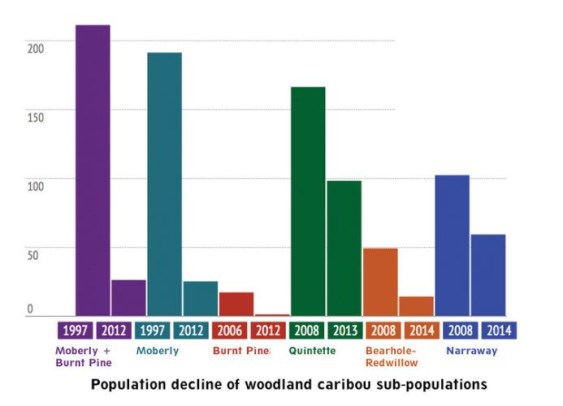A new study warns a type of woodland caribou is nearing extinction despite conservation efforts, and links that decline to significant habitat loss.
"It's a rather depressing story to have to tell and it's one we wanted to let people know about," said Chris Johnson, an ecology professor and one of the authors of the study, published in Biological Conservation in March.
The researchers studied five sub-populations found in northeast B.C. to look at the connection between population levels and habitat loss for the central mountain caribou, which is considered "evolutionarily distinct."
On average, the population has declined by 64 per cent since the mid 1990s, Johnson said. Several of those populations have less than 20 animals and one of the five populations they studied has been classified as extirpated - or eradicated - with one caribou recorded in 2012 despite having 17 caribou six years before.
"Although habitat change has been significant, it's a complex set of factors which has probably led to the demise of these caribou," said Johnson, like getting hit on highways, loss of access to old forest in the winter which they prefer, and less space to get away from predators.
The biggest threat has probably been the increased levels of predation from wolves and bears, he said.
But that, too, is tied to habitat loss.
"We know that when we disturb these boreal and sub-boreal forests we create lots of what's called early successional forage and that forage is great habitat for moose and elk and deer," he said, which then draws the predators.
"More bears and wolves result in fewer caribou."
WOLF CULL
The Ministry of Forests, Lands and Natural Resource Operations referred to the wolf kill program as an important aspect of caribou conservation.
"Government recognizes that habitat restoration and protection are a necessary element of recovering caribou herds," said the statement.
"However, we also know that habitat protection is not enough. That's why we're also undertaking wolf control measures."
The wolf control program will occur over five years and it will take that time to see if it is successful, the statement said.
This year 84 wolves were killed, less than half of the 184 the province initially announced hunters would shoot. The cull began Jan. 15 in the South Selkirks and the South Peace regions. In the South Peace, the forest ministry said wolves account for 37 per cent of all adult caribou deaths.
Despite the controversy of the cull, Johnson said it is a necessary but likely a short term solution.
"We basically need to buy these caribou some time," he said.
HABITAT LOSS AND PROTECTION
The study examined habitat loss - typically due to development - over a 22-year-period and from 2000 to 2011 followed geo-tagged caribou to watch their interactions with the affected areas.
"The data also showed us that caribou were avoiding many of the industrial features we looked at," he said in reference to disturbances caused by roads, clearcuts, seismic lines as well as wildfires.
The study reported dramatic habitat loss, which strongly correlated with population decline, Johnson said. The Bearhole - Redwillow subpopulation had lost as much as 66 per cent of its high quality habitat - and now has 14 caribou on record, down from 49 in 2008.
Addressing the loss of habitat will take a proactive approach to conservation, he said.
"You simply can't turn the clock back so we need to be proactive in sort of maintaining some of those existing caribou habitats. We need to think about restoration. What would that look like, what would that cost?"
Johnson referred to habitat protection and a maternal penning program for one group, which keeps the caribou penned for the early months of a calf's life.
"There's been some habitat protection, but I still think there's room to go. Government is still trying to find a balance between socioeconomics and caribou conservation."
Johnson criticized the Peace North Caribou Plan, set out in 2012, which protects 90 per cent of "critical habitat" for caribou and 80 per cent for the Quintette subpopulation (one of the few "relatively stable" subpopulations, Johnson said).
The ministry said there was no plan to change those guidelines and that it will "continue to implement the Peace Northern Caribou Plan (PNCP), which was developed based on the best available science and technical information available."
The ministry said it has been working to minimize habitat fragmentation and support long-term habitat conditions.
"Every other mitigation effort, including addressing habitat protection and recovery, has already been well underway for some time," the statement said.
To date, the province has protected more than one million hectares of land from development and also requires anyone who disturbs caribou habitat to set aside four hectares for every one hectare disturbed.
That program has meant about 6,000 hectares have been set aside and 1,500 hectares disturbed.
"Through a combination of these measures, and existing parkland, the PNCP will ultimately protect over 498,000 hectares of high elevation winter range caribou habitat out of a total of 553,477 available," the ministry statement said.
Even that small loss of critical land can make a difference for the endangered caribou given the "dire straights" the caribou are in, Johnson argued.
"That doesn't seem to make very good conservation sense for these animals given the steep rate of decline," he said. "If they're already declining at this rate and they're already turning toward extinction it's hard to understand how losing another 10 or 20 per cent of their habitat is going to do anything but make it even worse for them."
-- with files from the Canadian Press



